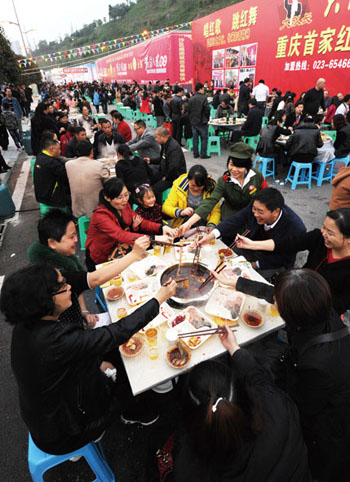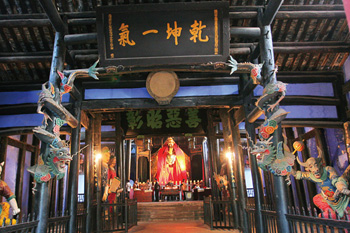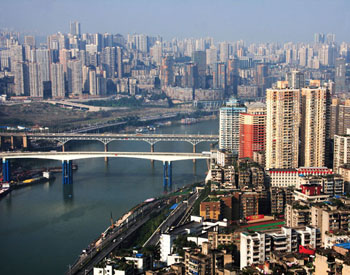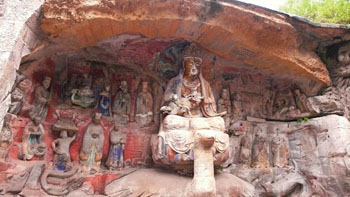
Written by: Tie Mei
Posted on: January 16, 2013 |  | 中文
| 中文
Chongqing is a renowned historic city with 3,000 years of cultural heritage. It is also the youngest municipality of China and the world's largest inland city with hilly slopes and a river that runs around it. It is a huge city as it has the largest administrative area and the largest population in China. The city center is encircled by the Yangtze and Jialing Rivers. Row upon row of buildings can be seen on the hilly slopes and by the river, which has earned for it the nicknames ‘Hilly City’ and ‘City by the River.’
CHONGQING
Tie Mei
 On the world map in the hall of the United Nations, four cities in China are marked, including Chongqing. It is a renowned historic city with 3,000 years of cultural heritage. It is also the youngest municipality and the largest inland city of China with hilly slopes and a river around it. Covering an area of 82,400 square kilometers, it is a big city, with the largest administrative area and the largest population in China.
On the world map in the hall of the United Nations, four cities in China are marked, including Chongqing. It is a renowned historic city with 3,000 years of cultural heritage. It is also the youngest municipality and the largest inland city of China with hilly slopes and a river around it. Covering an area of 82,400 square kilometers, it is a big city, with the largest administrative area and the largest population in China.
Chongqing is a famous historical and cultural city of China. Evidence of human existence in Chongqing dates back to the end of the Old Stone Age, some 20,000 to 30,000 years ago. During the Shang and Zhou Periods in the 11th century BC, Chongqing was the capital of the Ba Kingdom. More than 800 years ago, the inauguration of an emperor of the Song Dynasty was held here, and he marked his celebrations by naming the city ‘Chongqing,’ which means ‘double celebration’.
In 1891, Chongqing became the earliest inland port in China for export. Functioning as a strategic hub in Central West China and the economic center in the upper reaches of the Yangtze River, Chongqing is the largest multi-functional modern industrial and commercial city. The Three Gorges Dam that draws world-wide attention and the exploration of residence relocation brings vigor to the development of Chongqing. It is the key development zone of the Grand West Development Project of the state.
The network of rivers including the Yangtze River, the Jialing River and the Wujiang River, and the hills and mountains are the characteristic topographical features of Chongqing. The Yangtze River flows through the city from the west to the east with a flow path of 665 km and presents the world famous scenery of the Three Gorges. As the old city of Chongqing is encircled by the Yangtze and Jialing Rivers, rows of buildings can be seen on the hilly slopes and by the river; hence, the city’s nicknames of ‘Hilly City’ and ‘City by the River.’ When night falls, the myriad lights twinkling, together with the river and sky?add radiance to each other, making the city look as splendid and beautiful as the starry sky.
 Chongqing is the only transportation network in West China that integrates water, land and air transportation. It is a solid industrial base for coal in South China. It tops the list in the country in terms of abundant water resources per square kilometer. It has the largest production plant for aluminum in Asia. The number of motorcycles that are produced in Chongqing makes up one third of the total output of the country. Great strength in scientific research and education is safeguarded by its research institutes (more than 1,000), universities and colleges (34) as well as professionals of science and technology (more than 600, 000).
Chongqing is the only transportation network in West China that integrates water, land and air transportation. It is a solid industrial base for coal in South China. It tops the list in the country in terms of abundant water resources per square kilometer. It has the largest production plant for aluminum in Asia. The number of motorcycles that are produced in Chongqing makes up one third of the total output of the country. Great strength in scientific research and education is safeguarded by its research institutes (more than 1,000), universities and colleges (34) as well as professionals of science and technology (more than 600, 000).
The total population of Chongqing is more than 30 million and there are 49 nationalities, including Han, Tujia, Miao, and Hui, to name a few. Ethnic minorities keep to their distinctive traditional customs. The Diaojiao Lou of the Tujia people (suspended wooden buildings near water and at the foot of mountains), the Miao embroidery and Batik are some of the unique features.
Fishermen’s Chant is a kind of folk song of Chongqing. In July 1987, in Avignon, France, in an art festival titled “World Rivers Meet at Seine,” a folk art exchange program, Chongqing artists amazed the audience with their thunderous song which was praised as the “music of the rivers”. Chongqing is home to a variety of labor chants, including Stone Chant (sung by people whose job is to break stones) and Road Name Chant (sung by people whose job is to carry bamboo sedan chairs with people riding in them). Since ancient times, story-telling as a part of oral literature has been well received by the local people.
 The people of Chongqing have hot pot food all year round, so ‘Hot Pot’ is another nickname for Chongqing. The people here enjoy very pungent and spicy hot pot food, and they have it regardless of the time of year, even when it is over 30°C in summer.
The people of Chongqing have hot pot food all year round, so ‘Hot Pot’ is another nickname for Chongqing. The people here enjoy very pungent and spicy hot pot food, and they have it regardless of the time of year, even when it is over 30°C in summer.
Tourist Destinations
Fengdu County, the Ghost Town
According to traditional Chinese beliefs, human beings turn into ghosts after they die. As legend has it, the Ghost Town is where these ghosts live. Fengdu County has a history of nearly 2,000 years and is well known as the Capital of Ghosts and the Land of the Dead. According to ancient Chinese documents, there were three palaces and nine mansions in Fengdu County, which were as gorgeous as the Celestial Temple, the seat of the ghost king who was supposed to rule millions of ghosts. Fengdu is the so-called destination of the ghosts, home to China’s divine song, and home to human spirits.
Located on the north bank of the lower reaches of the Yangtze River, 172 km away from Chongqing, Fengdu has the largest dynamic cultural landscape in China. It has received many famous visitors, including Henry Alfred Kissinger, former US Secretary of State George Shultz, and Toshiki Kaifu and Nakasone Yasuhiro, former Japanese Prime Ministers.
Wushan Known as the east gate of Chongqing, Wushan has a long history and abounds with cultural and historic heritages as well as a unique charm. Longgupo Site of Wushan is where the ancient fossils of human beings that lived about 200 million years ago were found. The Three Gorges Man and Wushan Man, the earliest homo erectus in Asia, kindled the fire of civilization here. Daxi Town, where the Neolithic Site is located, has 5,000 years of history and is home to the famous Daxi Culture, which was not discovered until the 1980s. The Little Three Gorges was on the list of National Natural Reserve in 1982 and was selected as a AAAA tourist destination in 2000.
Known as the east gate of Chongqing, Wushan has a long history and abounds with cultural and historic heritages as well as a unique charm. Longgupo Site of Wushan is where the ancient fossils of human beings that lived about 200 million years ago were found. The Three Gorges Man and Wushan Man, the earliest homo erectus in Asia, kindled the fire of civilization here. Daxi Town, where the Neolithic Site is located, has 5,000 years of history and is home to the famous Daxi Culture, which was not discovered until the 1980s. The Little Three Gorges was on the list of National Natural Reserve in 1982 and was selected as a AAAA tourist destination in 2000.
Dazu Stone Carvings
In December 1999, UNESCO declared the Dazu Stone Carvings as a world cultural heritage site. The cliffside carvings of Dazu from the 9th century to the 13th century are acknowledged to be unique. They are known for their high artistic quality and diversity of themes ranging from secular life to religious belief, which reflects the social realities of the time and proves that Buddhism, Daoism and Confucianism were in harmony in that period.
The site of the Dazu Stone Carvings, 15 km away from Dazu County, is known as home to stone carvings. It began in the year 649, showcasing the essence of stone carving masterpieces. In terms of scale, it stands shoulder to shoulder with Yungang Grottoes, Longmeng Grottoes, and Mogao Grottoes. Seventy-odd sites display over 100,000 grottoes. Being an important component in grottoes art, the Dazu Stone Carvings have been a marvelous page in the history of world stone carving from the end of the 9th to the mid-13th century.
You may also like: